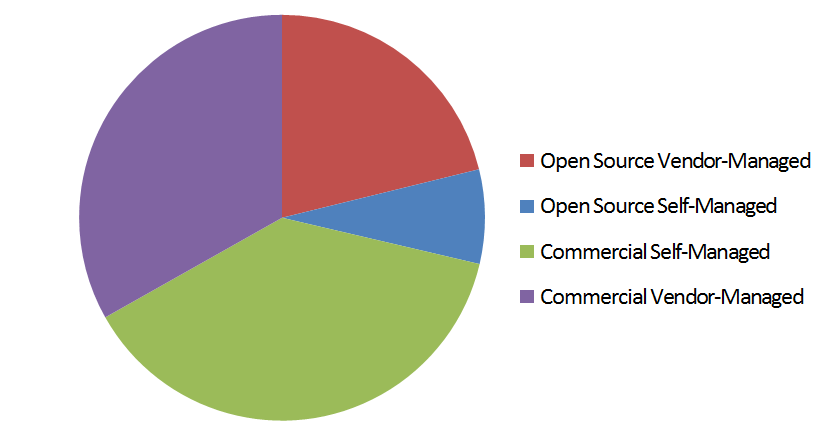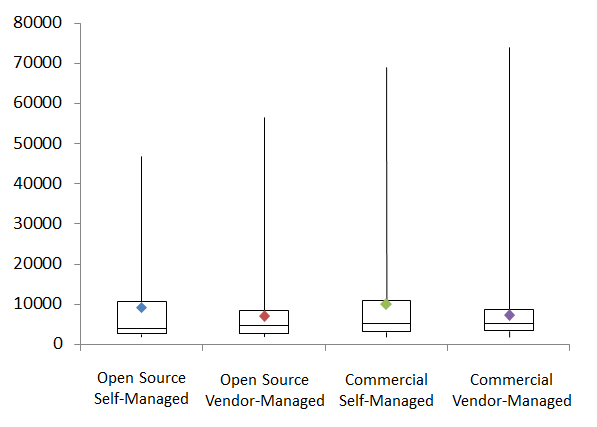As we continued our exploration of institutional LMS data we became very curious about correlations between institutional characteristics and their LMS choices. We chose to focus on whether an institution’s LMS is open source or not and whether it is vendor-managed (ie: hosted) or self-managed (aka: on-premises). For the purposes of this post, we considered our US dataset covering all institutions with greater than 2000 enrollments. Additionally, we limited our exploration to all types of LMSs excluding the legacy and other categories. For clarification, we categorized Instructure Canvas as an open source LMS and vendor-hosted Moodle and Sakai as “vendor-managed” open source.
Our findings indicate that roughly one-third of institutions have chosen to use open source LMSs. Of those that have chosen an open source solution, a significant majority have partnered with a vendor to host or manage their LMS. The other two-thirds of institutions have chosen a commercial LMS with roughly half choosing to host with their vendor and the other half choosing to self-host.
What is interesting is that institutions tend to have adopted these different LMS models almost uniformly across institutions when considering enrollment data alone. The boxes below represent the middle 50% of data for each category. You can see that they are roughly in alignment. You can also see that the median and mean for each category are not too dissimilar. The only real difference is that commercial, hosted LMSs tend to support those institutions with the largest numbers of enrollments. Remember, our analysis considers each institution individually (and corresponding enrollment numbers individually) with regards to LMS choice. Schools with branch campuses, for example, are considered separately and not rolled up into a single entity for this comparison. Special thanks to a friendly Operations Research analyst for helping us to make sense of this data.
Even though the enrollment data doesn’t show much difference, we began to wonder – are there other factors that do? We then discussed turning to the Carnegie Classifications for some clues. Here’s what we found.
The most common types of institutions that use an open source, self-managed LMS are:
- Master’s L: Master’s Colleges and Universities (larger programs)
- RU/VH: Research Universities (very high research activity)
- Bac/A&S: Baccalaureate Colleges–Arts & Sciences
For open source, vendor-managed solutions, the most common types are:
- Master’s L: Master’s Colleges and Universities (larger programs)
- Assoc/Pub-U-MC: Associate’s–Public Urban-serving Multicampus
- Assoc/Pub-R-M: Associate’s–Public Rural-serving Medium
Those institutions most likely to implement a commercial, self-managed LMS are:
- Master’s L: Master’s Colleges and Universities (larger programs)
- Assoc/Pub-R-M: Associate’s–Public Rural-serving Medium
- RU/VH: Research Universities (very high research activity)
And finally, those choosing to let a vendor manage their commercial LMS are:
- Master’s L: Master’s Colleges and Universities (larger programs)
- Assoc/Pub-R-M: Associate’s–Public Rural-serving Medium
- Assoc/Pub-R-L: Associate’s–Public Rural-serving Large
The category of “Master’s L: Master’s Colleges and Universities (larger programs)” is distributed evenly and appears as the top type of school likely to choose each category of solution. This makes sense as it is the second most common type of institution according to the Carnegie Classifications.
Finally, certain types of institutions appear evenly distributed across both open source and commercial solutions but display a strong preference towards hosting/vendor-managed solutions:
- Assoc/Pub-R-M: Associate’s–Public Rural-serving Medium
- Assoc/Pub-R-L: Associate’s–Public Rural-serving Large
- Assoc/Pub-U-MC: Associate’s–Public Urban-serving Multicampus
- Master’s L: Master’s Colleges and Universities (larger programs)
There are also a few outliers to note as well. The “other” category of LMS that we are tracking includes homegrown and other commercial and open source LMSs. There are four particularly-large universities, each having enrollments of 70,000+ according to current NCES data, that are interesting to mention: Kaplan, Ashford, Virginia College, and University of Phoenix. Phoenix uses a homegrown LMS. A couple years ago, Ashford migrated off of Blackboard and now uses Learning Studio by Pearson. Kaplan appears to use a blend of LMSs that includes in-house development, acquired technology, and other commercial solutions including ComplianceWire and Learning Studio by Pearson. Virginia College also appears to use a blend of in-house development and also Pearson’s LearningStudio.
Pearson’s offering is quite the interesting one. A small subset of eCollege/Learning Studio institutions are significantly large, but a full 80% of known institutions using Pearson’s LMS products have fewer than 9000 enrollments. Excluding the larger-sized outliers, the average Pearson institution only has roughly 4000 students on average – significantly lower than the average of any other major LMS.

